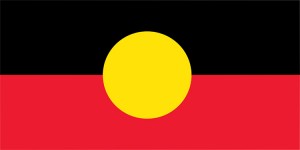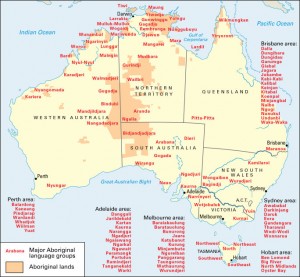Language Monday: Aboriginal Languages of Australia
January 22, 2018
Australia is a land with a great diversity (variety) of languages. There were likely more than 250 distinct indigenous (native) languages spoken by Aboriginal peoples in the 1780’s when Europeans began settling in Australia. There were no written records before Europeans arrived in Australia, so linguists—scholars who study languages—can only surmise the history of these languages by studying modern speakers. Linguists divide these 250 languages among 25 or more language families. By contrast, modern Europe has nearly as many languages, but most fall within just three main language families.

The Aboriginal flag features a black rectangle (representing Australia’s Aboriginal peoples) atop a red rectangle (representing the red soil of their traditional land). In the center of the flag is a yellow circle representing the sun, uniting the people with their land. Credit: © Harold Thomas. Used with permission.
Aboriginal Australian languages are clearly related to one another, but linguists do not relate them to any other languages in the world. One Australian language family is much larger than the others. The regions in which languages of the Pama-Nyungan family are spoken cover about 90 percent of Australia. Linguists generally place over 150 languages into this family. The Pama-Nyungan languages with the most speakers include Tiwi, Walmatjari, Warlpiri, Aranda, Mabuyag, and Western-Desert. Australia’s other language families are mostly very small. Some of them consist of only one or two languages. Nearly all have fewer than 1,000 speakers and many are in danger of becoming extinct.

Click to view larger image
Aboriginal language groups today are concentrated in regions with dense populations. Aboriginal people of Australia spoke about 250 distinct languages—with about 600 dialects—at the time European settlers arrived in 1778. About 145 Aboriginal languages are spoken in Australia today. Credit: WORLD BOOK map
Aboriginal languages had a grammatical structure and a rich and complex vocabulary. In addition to everyday vocabularies (usually about 10,000 words), many languages also included specialized words. Specialized language forms were used in songs and rituals, in jokes, and in conversation between certain people. Many words describe aspects of the Dreamtime, a fundamental spiritual concept that connects traditional beliefs and practices among Aboriginal people of Australia.
Many Aboriginal words are still used today to describe the unique landforms, places, animals, and plants of Australia. For example, the British explorer James Cook first heard the word kangaroo in what is now Queensland in 1770. The word then spread to all parts of Australia. Other Aboriginal words that have become common include billabong (a small pool or lake), cooee (come here), boomerang (a weapon), and the legendary creatures bunyip and yowie. Many towns and cities in Australia have Aboriginal names, including Woomera (spear-thrower), Cooma (big lake), and Dubbo (red earth). Australia’s capital city, Canberra, is said to get its name from a Ngunnawai word meaning meeting place.
The future of Aboriginal languages in Australia is uncertain. From 1870 until about 1970, thousands of Aboriginal children were separated from their families. These “stolen generations” were placed in institutions, missions, and foster homes where their native languages were forbidden. Today, this practice has ended, and several Aboriginal languages are spoken and taught in bilingual schools. Many Aboriginal people in Australia increasingly maintain significant elements of their traditional lifestyle—including their indigenous language. The Australian Institute for Aboriginal Studies and other organizations promote the study and preservation of many of these languages today. In 2015, the Noongar Recognition bill, which included a passage written in the Noongar Aboriginal language, was introduced into the parliament of Western Australia. The hope is that most Aboriginal languages will remain a vital aspect of Australian culture for generations to come.


